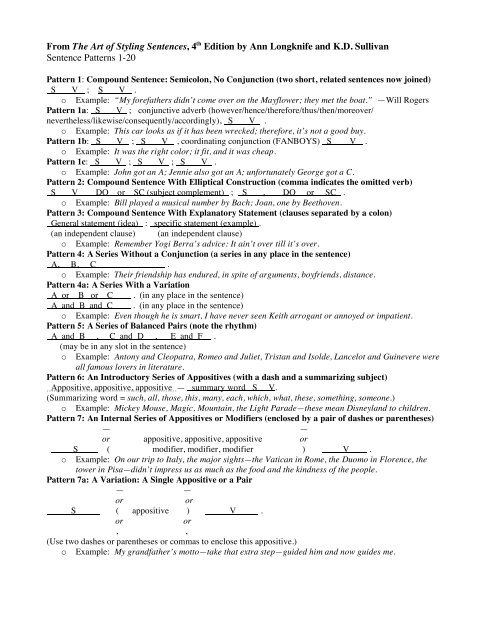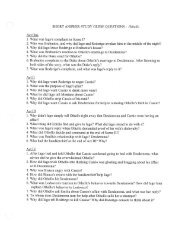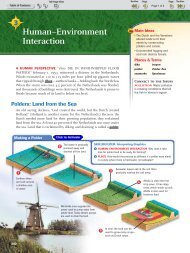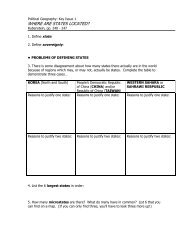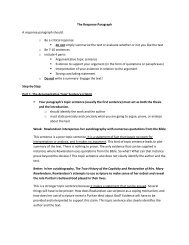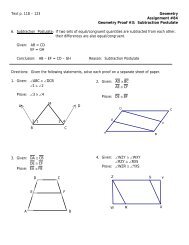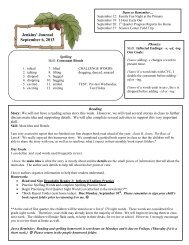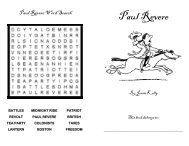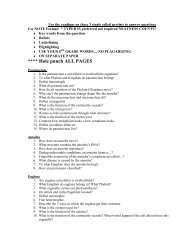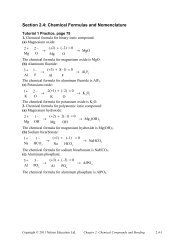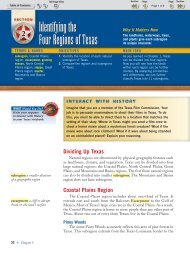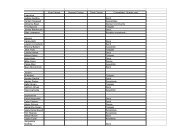Sentence Patterns 1-20.pdf - Teacher
Sentence Patterns 1-20.pdf - Teacher
Sentence Patterns 1-20.pdf - Teacher
You also want an ePaper? Increase the reach of your titles
YUMPU automatically turns print PDFs into web optimized ePapers that Google loves.
From The Art of Styling <strong>Sentence</strong>s, 4 th Edition by Ann Longknife and K.D. Sullivan<br />
<strong>Sentence</strong> <strong>Patterns</strong> 1-20<br />
Pattern 1: Compound <strong>Sentence</strong>: Semicolon, No Conjunction (two short, related sentences now joined)<br />
S V ; S V .<br />
o Example: “My forefathers didn’t come over on the Mayflower; they met the boat.” —Will Rogers<br />
Pattern 1a: S V ; conjunctive adverb (however/hence/therefore/thus/then/moreover/<br />
nevertheless/likewise/consequently/accordingly), S V .<br />
o Example: This car looks as if it has been wrecked; therefore, it’s not a good buy.<br />
Pattern 1b: S V ; S V , coordinating conjunction (FANBOYS) S V .<br />
o Example: It was the right color; it fit, and it was cheap.<br />
Pattern 1c: S V ; S V ; S V .<br />
o Example: John got an A; Jennie also got an A; unfortunately George got a C.<br />
Pattern 2: Compound <strong>Sentence</strong> With Elliptical Construction (comma indicates the omitted verb)<br />
S V DO or SC (subject complement) ; S , DO or SC .<br />
o Example: Bill played a musical number by Bach; Joan, one by Beethoven.<br />
Pattern 3: Compound <strong>Sentence</strong> With Explanatory Statement (clauses separated by a colon)<br />
General statement (idea) : specific statement (example) .<br />
(an independent clause) (an independent clause)<br />
o Example: Remember Yogi Berra’s advice: It ain’t over till it’s over.<br />
Pattern 4: A Series Without a Conjunction (a series in any place in the sentence)<br />
A, B, C .<br />
o Example: Their friendship has endured, in spite of arguments, boyfriends, distance.<br />
Pattern 4a: A Series With a Variation<br />
A or B or C . (in any place in the sentence)<br />
A and B and C . (in any place in the sentence)<br />
o Example: Even though he is smart, I have never seen Keith arrogant or annoyed or impatient.<br />
Pattern 5: A Series of Balanced Pairs (note the rhythm)<br />
A and B , C and D , E and F .<br />
(may be in any slot in the sentence)<br />
o Example: Antony and Cleopatra, Romeo and Juliet, Tristan and Isolde, Lancelot and Guinevere were<br />
all famous lovers in literature.<br />
Pattern 6: An Introductory Series of Appositives (with a dash and a summarizing subject)<br />
Appositive, appositive, appositive — summary word S V.<br />
(Summarizing word = such, all, those, this, many, each, which, what, these, something, someone.)<br />
o Example: Mickey Mouse, Magic, Mountain, the Light Parade—these mean Disneyland to children.<br />
Pattern 7: An Internal Series of Appositives or Modifiers (enclosed by a pair of dashes or parentheses)<br />
— —<br />
or appositive, appositive, appositive or<br />
S ( modifier, modifier, modifier ) V .<br />
o Example: On our trip to Italy, the major sights—the Vatican in Rome, the Duomo in Florence, the<br />
tower in Pisa—didn’t impress us as much as the food and the kindness of the people.<br />
Pattern 7a: A Variation: A Single Appositive or a Pair<br />
— —<br />
or or<br />
S ( appositive ) V .<br />
or or<br />
, ,<br />
(Use two dashes or parentheses or commas to enclose this appositive.)<br />
o Example: My grandfather’s motto—take that extra step—guided him and now guides me.
Pattern 8: Dependent Clauses in a Pair or in a Series (at beginning or end of sentence)<br />
If…, if…, then S V .<br />
When…, when…, when…, S V .<br />
S V that…, that…, that…<br />
(omit the third clause and have just two, if you wish)<br />
o Example: If he had the money, if he had the time, if he had a companion, he would take that trip around<br />
the world.<br />
Pattern 9: Repetition of a Key Term<br />
—<br />
S V key term or repeated key term .<br />
,<br />
(use dash or comma before repetition)<br />
Repeated term: brute may become brutal; breath may become breathtaking; battle may become battling.<br />
o Example: We all have problems but we can find a solution, a solution that works, a solution that is<br />
equitable.<br />
Pattern 9a: A Variation: Same Word Repeated in Parallel Structure<br />
S V repeated key word in same position of the sentence.<br />
o Example: Rodin’s The Thinker presents the perfect figure in the perfect pose.<br />
o Example: If you have unrealistic dreams, you may need to find other goals, other desires.<br />
Pattern10: Emphatic Appositives at End, After a Colon<br />
S V word: the appositive (the second naming) .<br />
(with or without modifiers)<br />
o Example: Her room contained a collection of trash: old clothes, soda cans, McDonald’s wrappers.<br />
Pattern 10a: A Variation: Appositive (single or pair or series) After a Dash<br />
S V word — the appositive .<br />
(echoed idea or second naming)<br />
o Example: Pandas eat only one food—bamboo shoots.<br />
o Example: E-mail is wonderful and so easy to send but also represents a major problem—answering it.<br />
Pattern 11: Interrupting Modified Between S and V<br />
_ S_ , modifier , _V_ .<br />
_ S_ — modifier — _V_ .<br />
_ S_ (modifier that whispers) _V_ .<br />
o Example: A small drop of ink, falling (as Byron said) like dew upon a thought, can make millions think.<br />
o Example: Wolves—once feared and killed—are being reintroduced into the environment.<br />
o Example: Relaxation and informality are important parts of our fantasies about life in a tropical<br />
paradise, and once you get accustomed to having twenty people waiting on you hand foot (it doesn’t<br />
take very long), you no longer feel like a guest.<br />
Pattern 11a: A Full <strong>Sentence</strong> (statement or question or exclamation) as Interrupting Modifier<br />
—a full sentence—<br />
__S__ or __V__<br />
(a full sentence)<br />
o Example: Juliet’s famous question—early in the balcony scene she asks, “Wherefore art thou<br />
Romeo?”—is often misunderstood; she meant not “where,” but “why.”<br />
o Example: One of Thoreau’s most famous analogies—“If a man does not keep pace with his<br />
companions, perhaps it is because he hears a different drummer. Let him step to the music he hears,<br />
however measured or far away.”—echoes Shakespeare’s advice that we should be true to ourselves.<br />
NOTE: Here the statement before the dash is a quotation, and the period is correct.<br />
o Example: He leaped at the chance (too impetuously, I thought) to go whitewater rafting.<br />
Pattern 12: Introductory or Concluding Participles<br />
Participial phrase , ______S_______V______ .<br />
____S_________V__________ , Participial phrase .<br />
o Example: Persevering, determined to succeed, driven by wanderlust, blest with discipline, the pioneers<br />
forged a civilization out of a wilderness.<br />
[Persevering (present regular), determined (past regular), driven (past irregular), blest (past irregular)]
Pattern 13: A Single Modifier Out of Place for Emphasis<br />
Modifier , ______S_______V______ .<br />
(modifier may be in other positions)<br />
o Example: Inside, the child was noisy. (NOTE: the comma is vital here—why?)<br />
o Example: Frantic, the young hiker rushed over with the rescue rope.<br />
o Example: The general demand absolute obedience, instant and unquestioning.<br />
o Example: All day the walkers sweated in the sun, pleased that they were walking for a good cause—<br />
preventing breast cancer.<br />
Pattern 14: Prepositional Phrase Before S and V<br />
Prepositional phrase ___S V (or V S) .<br />
o Example: After a long pause, the teacher continued.<br />
o Example: In the park the ducks waddled toward the pond.<br />
o Example: Under the care of Bishop Jean Baptist Lamy, Sante Fe, New Mexico, became an important,<br />
thriving village.<br />
Pattern 15: Object or Complement Before S and V<br />
Object or Subject complement S V .<br />
o Example: His kind of sarcasm I do not like.<br />
o Example: Satisfied with his first draft, good grades he will never have.<br />
o Example: No friend of snakes is my sister Jean.<br />
Pattern 15a: Complete Inversion of Normal Pattern<br />
Object or Complement or Modifier V S .<br />
o Example: Westward the country was free; (Mod S V C)<br />
westward, therefore, lay their hopes; (Mod V S)<br />
westward flew their dreams. The West became (Mod V S)<br />
for everyone the promised land of milk and honey. (Prep. Phrase out of place<br />
between V and SC)<br />
o Example: From the guru’s prophecy radiated a faith that ultimately all would be well.<br />
o Example: Down the field and through the weeds pranced the little puppy.<br />
Pattern 16: Paired Constructions<br />
Not only S V , but also S V . (The also may be omitted.)<br />
Just as S V , so too S V . (may be so also or simply so)<br />
The more S V , the more S V . (may be the less)<br />
The former S V , the latter S V .<br />
If not , at least * . (*Note that the if not…at least construction joins<br />
individual grammatical units, not complete clauses.)<br />
o Example: if not praise, at least not blame<br />
o Example: Just as the Yankees dominate the World Series, so Tiger Woods dominates the golf world.<br />
o Example: The more he tried to please, the less pleased I was.<br />
Pattern 16a: A Paired Construction for Contrast Only<br />
A “this, not that” or “not this but that” construction .<br />
in some place other than the verb position<br />
o Example: For some hummingbirds, migration involves a much smaller range, measure in hundreds, not<br />
thousands, or miles.<br />
o Example: Hard work, not luck, gets you promotes in business.<br />
o Example: The judge asked for acquittal—not conviction.<br />
Pattern 17: Dependent Clause (in a “sentence slot”) as Subject or Object or Complement<br />
S [dependent clause as subject] V .<br />
S V [dependent clause as object or complement] .<br />
NOTE: The dependent clauses in this pattern, which serve as nouns, will begin with one of the following<br />
words: who, whom, which, that, what, why, where, when, how<br />
o Example: How he did that is still amazing to me.<br />
o What man cannot imagine, he cannot create.<br />
o Anne never discovered why her husband bought her a diamond necklace.
Pattern 18: Absolute Construction (noun plus participle) Anywhere in <strong>Sentence</strong><br />
Absolute construction , S V .<br />
S , absolute construction , V .<br />
— or —<br />
( or )<br />
o Example: The walls being blank, the new tenant—an unemployed artist—promptly set about covering<br />
all of them in a mural of orange, vermillion, and yellow.<br />
o Example: I want to go away to college (my parents willing) as soon as I graduate from high school.<br />
o Example: The snow having stopped, we were able to continue our journey.<br />
Pattern 19: The Short, Simple <strong>Sentence</strong> for Relief or Dramatic Effect<br />
S V .<br />
o Examples: Well, I wonder; Days passed; It was magical; That is okay; Everything changed.<br />
Pattern 19a: A Short Question for Dramatic Effect<br />
(Interrogative word) auxiliary verb S V ?<br />
(Interrogative word standing alone) ?<br />
(Question based solely on intonation) ?<br />
Auxiliary verb S V ?<br />
o Examples: Can we change? How did she cope? What is next?<br />
Was it easy? What if E.T. calls? That’s her mother?<br />
Pattern 20: The Deliberate Fragment<br />
Merely a part of a sentence<br />
o Examples:<br />
1. in a description—<br />
I wish you could have known the Southwest in the early day. The way it really was. They way the land<br />
seemed to reach out forever. And those endless stretches of blue sky!<br />
2. for transition—<br />
Now, on with the story.<br />
Bit to get back to the subject.<br />
So much for that.<br />
3. for indication conclusions—<br />
Fair enough. All too late. No matter. Fine.<br />
4. in structuring a question or an answer—<br />
But why? And why not? What then? Nothing. Based on logic? Hardly!<br />
5. for making exclamations and for emphasis—<br />
What a price to pay! Probably not! Never! The next step—martyrdom.<br />
6. for making explanations—<br />
All to no avail. But for short journeys.<br />
7. and sometimes in aphorisms or fragments of clichés—<br />
The more the merrier for them, too. But there’s the rub.<br />
Early to bed! Absolute power corrupting once more.


